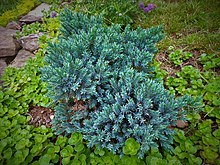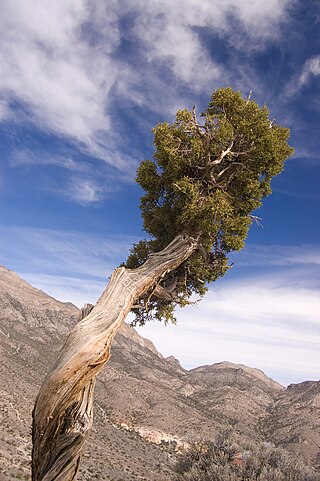
Junipers are coniferous trees and shrubs in the genus Juniperus of the cypress family Cupressaceae. Depending on the taxonomy, between 50 and 67 species of junipers are widely distributed throughout the Northern Hemisphere, from the Arctic, south to tropical Africa, throughout parts of western, central and southern Asia, east to eastern Tibet in the Old World, and in the mountains of Central America. The highest-known juniper forest occurs at an altitude of 4,900 metres (16,100 ft) in southeastern Tibet and the northern Himalayas, creating one of the highest tree lines on earth.
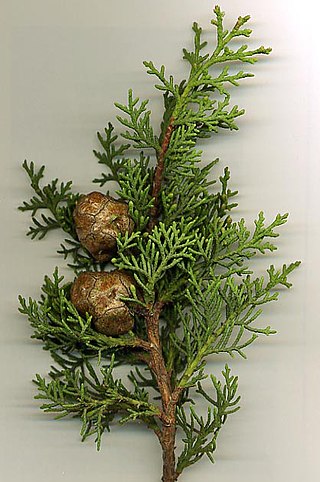
Cupressaceae is a conifer family, the cypress family, with worldwide distribution. The family includes 27–30 genera, which include the junipers and redwoods, with about 130–140 species in total. They are monoecious, subdioecious or (rarely) dioecious trees and shrubs up to 116 m (381 ft) tall. The bark of mature trees is commonly orange- to red- brown and of stringy texture, often flaking or peeling in vertical strips, but smooth, scaly or hard and square-cracked in some species.

Juniperus communis, the common juniper, is a species of small tree or shrub in the cypress family Cupressaceae. An evergreen conifer, it has the largest geographical range of any woody plant, with a circumpolar distribution throughout the cool temperate Northern Hemisphere.

Platycladus is a monotypic genus of evergreen coniferous trees in the cypress family Cupressaceae, containing only one species, Platycladus orientalis, also known as Chinese thuja, Oriental arborvitae, Chinese arborvitae, biota or Oriental thuja. It is native to northeastern parts of East Asia and North Asia, but is also now naturalised as an introduced species in other regions of the Asian continent.
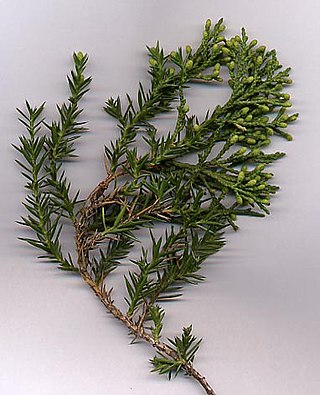
Juniperus chinensis, the Chinese juniper is a species of plant in the cypress family Cupressaceae, native to China, Myanmar, Japan, Korea and the Russian Far East. Growing 1–20 metres tall, it is a very variable coniferous evergreen tree or shrub.
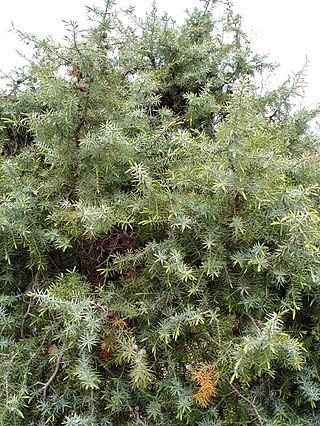
Juniperus oxycedrus, vernacularly called Cade, cade juniper, prickly juniper, prickly cedar, or sharp cedar, is a species of juniper, native across the Mediterranean region from Morocco and Portugal, north to southern France, east to westernmost Iran, and south to Lebanon and Israel, growing on a variety of rocky sites from sea level up to 1,600 metres in elevation. The specific epithet oxycedrus means "sharp cedar" and this species may have been the original cedar or cedrus of the ancient Greeks.

Microbiota is a monotypic genus of evergreen coniferous shrubs in the cypress family Cupressaceae, containing only one species, Microbiota decussata. The plant is native and endemic to a limited area of the Sikhote-Alin mountains in Primorskiy Krai in the Russian Far East. Microbiota is not to be confused with the range of microorganisms of the same name. The genus name was derived from micro-, meaning "small", + Biota, the genus name for a closely related conifer, a species formerly called Biota orientalis, now renamed Platycladus orientalis.
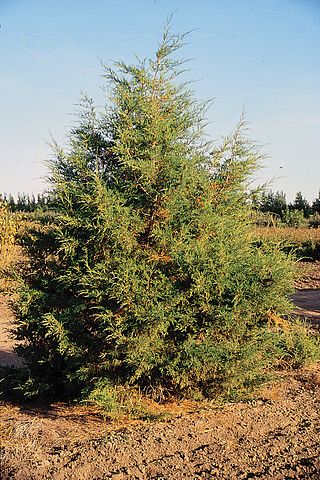
Juniperus scopulorum, the Rocky Mountain juniper, is a species of juniper native to western North America, from southwest Canada to the Great Plains of the United States.

Juniperus sabina, the savin juniper or savin, is a species of juniper native to the mountains of central and southern Europe and western and central Asia, from Spain to eastern Siberia, typically growing at altitudes of 1,000–3,300 metres.

Juniperus thurifera is a species of juniper native to the mountains of the western Mediterranean region, from southern France across eastern and central Spain to Morocco and locally in northern Algeria.
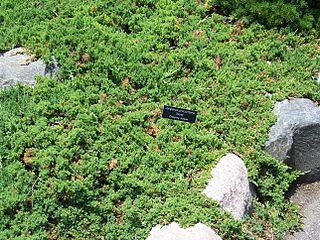
Juniperus procumbens is a species of shrub in the cypress family Cupressaceae, native to Japan. This low-growing evergreen conifer is closely related to the Chinese juniper, Juniperus chinensis, and is sometimes treated as a variety of it, as J. chinensis var. procumbens.
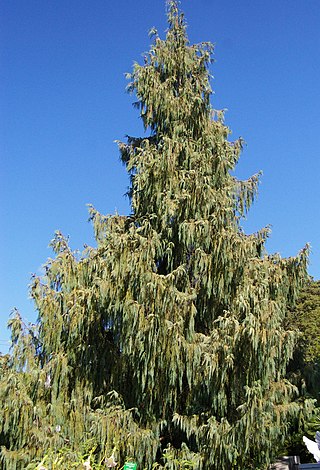
Cupressus cashmeriana, the Bhutan cypress or Kashmir cypress, is a species of evergreen conifer native to the eastern Himalaya in Bhutan and adjacent areas of Arunachal Pradesh in northeastern India. [ Now in vulnerable category, IUCN list retrieved in 2006 ]. It is also introduced in China and Nepal. It grows at moderately high altitudes of 1,250–2,800 metres (4,100–9,190 ft).
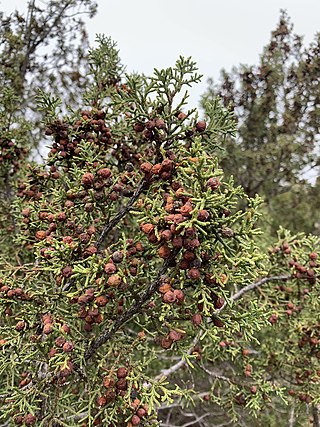
Juniperus pinchotii, commonly known as Pinchot juniper or redberry juniper, is a species of juniper native to south-western North America, in Mexico: Nuevo León and Coahuila, and in the United States: south-eastern New Mexico, central Texas, and western Oklahoma.
Juniperus przewalskii, or Przewalski's juniper, is a species of juniper native to the mountains of western China in Gansu, Qinghai, and northernmost Sichuan, growing at altitudes of 1,000-3,300 m.
Juniperus pseudosabina, the Turkestan juniper or dwarf black juniper is a species of juniper.

Juniperus rigida, the temple juniper, is a species of juniper, native to northern China, Mongolia, Korea, Japan, and the far southeast of Russia, occurring at altitudes of 10–2,200 metres (33–7,218 ft). The species is also naturalized in the United States. It is closely related to Juniperus communis and Juniperus conferta, the latter sometimes treated as a variety or subspecies of J. rigida.

Juniperus semiglobosa, the Himalayan pencil juniper, is a species of juniper native to the mountains of Central Asia, in northeastern Afghanistan, westernmost China (Xinjiang), northern Pakistan, southeastern Kazakhstan, Kyrgyzstan, western Nepal, northern Republic of India, Tajikistan, and Uzbekistan. It grows at altitudes of 1,550–4,420 metres.

Juniperus tibetica, the Tibetan juniper, is a species of juniper, native to western China in southern Gansu, southeastern Qinghai, Sichuan, and Tibet Autonomous Region, where it grows at high to very high altitudes of 2,600–4,900 metres. This species has the highest known elevation treeline in the northern hemisphere.

Juniperus lutchuensis or Ryūkyū juniper is a species of juniper native to the Ryūkyū Islands, Izu Islands, Izu Peninsula, and Bōsō Peninsula, Japan.
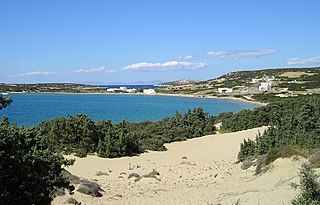
Juniperus macrocarpa is a species of juniper, native across the northern Mediterranean region from southwestern Spain east to western Turkey and Cyprus, growing on coastal sand dunes from sea level up to 75 metres in altitude.


